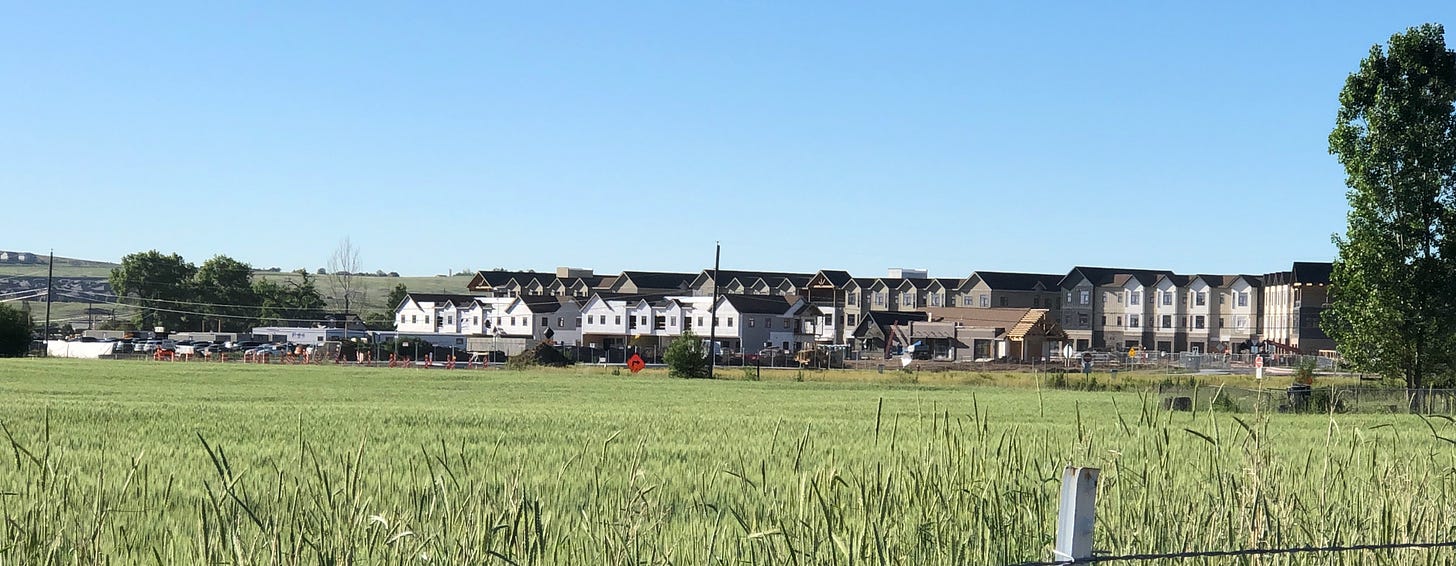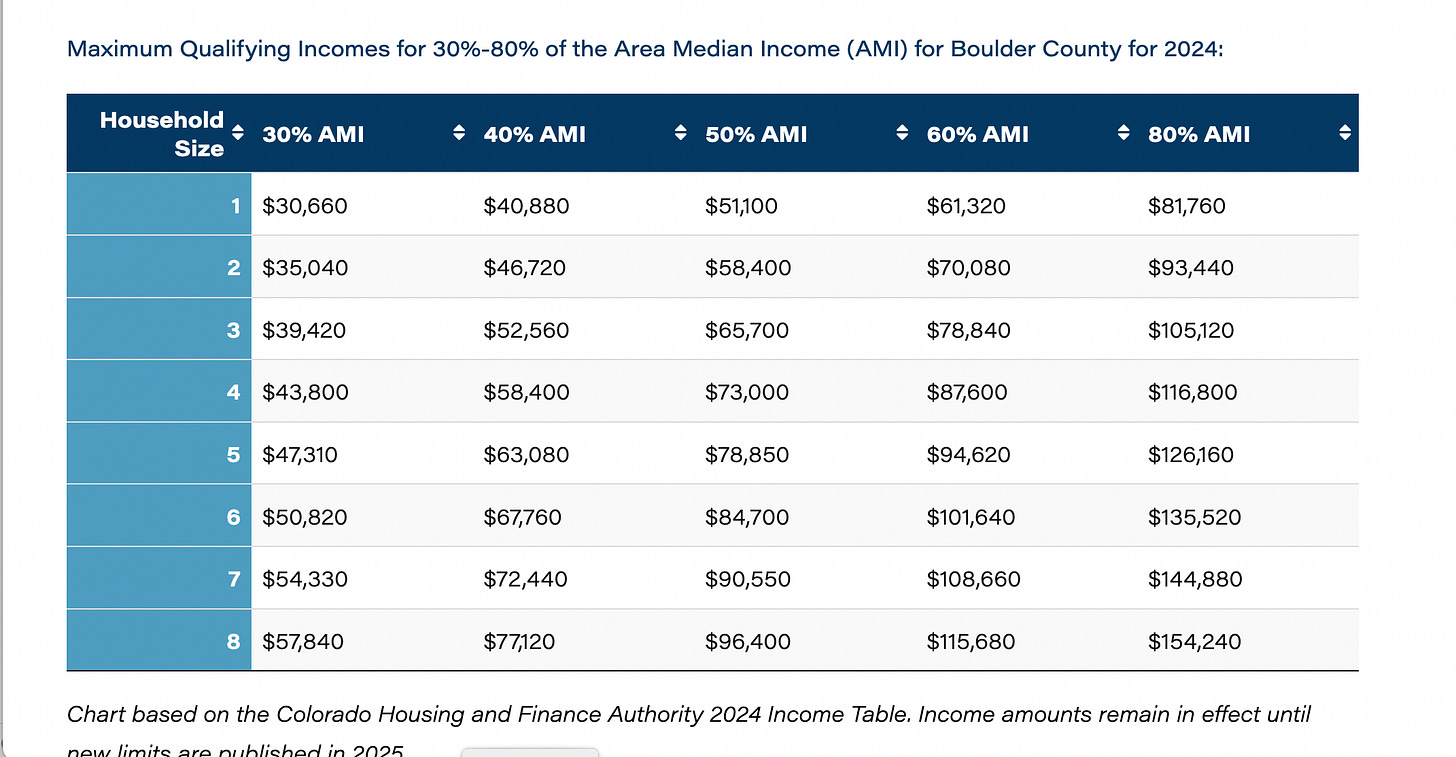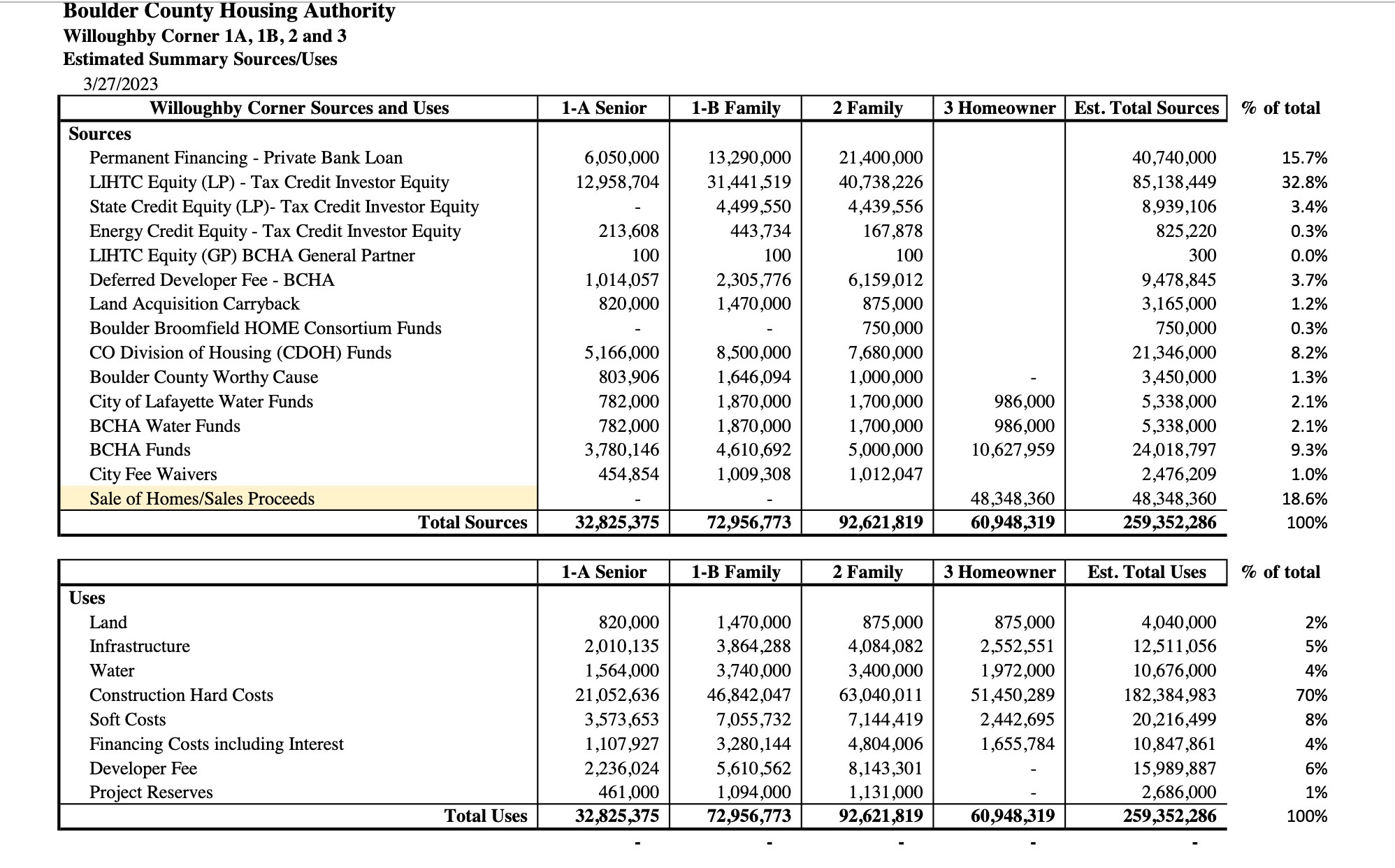How to apply for affordable housing at Willoughby Corner, plus some background
Mark your calendars for June 25th 8:30 a.m.
Photograph taken by yours truly on June 5th, 2024
HOW TO GET ON THE WAITLIST
Let’s get right to how to sign up for those of you who know about this project and then I’ll provide some more information. This is from a Boulder County Housing Authority email.
“We will be opening the waitlist for Phase 1 of Willoughby Corner on Tuesday, June 25, 2024, at 8:30 a.m. Phase 1 includes Búho Place (open to those 55 and older), as well as the Sugar Beet House, Peach Tree House, Blue Stem Place, and Purple Prairie Place (all of which are open to people of all ages).
Please note that in order to join the waitlist and eventually lease a Willoughby Corner property, applicants must first create a free account on WaitlistCheck. Those who require a reasonable accommodation to participate in the waitlist process should call 720-564-2267 no later than 4:00 p.m. on Friday, June 21, 2024.
If you want to learn more about the waitlist process, eligibility requirements for living at Willoughby Corner, or other frequently asked questions, we’re hosting an in-person informational open house on Tuesday, June 11, 2024, at the Southeast County Hub (1755 S. Public Road in Lafayette) from 6:00 to 7:30 p.m. English and Spanish speaking staff will be on hand to chat and answer questions. All are welcome!”
WILLOUGHBY CORNER BACKGROUND
Willoughby Corner is the Boulder County Housing Authority’s (BCHA) 400-unit affordable housing development at 120th and Emma. Lafayette does not have a housing authority so BCHA acts in that capacity for us.
I am a member of the East Lafayette Advisory Committee (ELAC) for this project. I have been reporting on it since watching the city council vote in 2017 to purchase the property from the Flatirons Church for $3,495,150.00 well before there was an ELAC.
At that time Lafayette and Boulder County signed an Intergovernmental Agreement (IGA) that requires 80% of all homes in Willoughby Corner to be deed-restricted for rent and purchase prices, with 20% for sale and 80% for rental. The homes must serve people earning at or below 60% of the Area Median Income (AMI). At least 10% of the rental homes must be for people 55 and older.
The land must be used for affordable housing in perpetuity.
The IGA.
WHAT DOES AFFORDABLE HOUSING MEAN?
The IGA states it is “housing for which the total cost of monthly rent payments, or the total cost of monthly payment of principal, interest, taxes, insurance including private mortgage insurance, and homeowner association dues, does not exceed the specified percentage of the Area Median Income and which is intended not to require payment of more than 30% of the gross monthly household income…”
THE 30% RULE
You might hear terms like cost-burdened, rent-burdened, or housing-burdened to describe those folks who are paying more than 30% of their income for housing.
WHAT’S THIS AMI STUFF KAREN?
Every year HUD, the US Department of Housing and Urban Development, determines the AMI for Boulder County. Here’s a chart created by the Colorado Housing and Finance Authority for 2024, showing what 30% to 80% of the AMI looks like.
A sidestep: I am hearing that the potential Thompson Thrift development at 111th and Arapahoe is being touted as having 12% of their units at 80% of the AMI. That’s one person earning $81,760.
OK KAREN WHAT ABOUT THIS 12% NUMBER?
In 2017 the Boulder County Regional Housing Partnership set a goal to triple the amount of affordable housing in Boulder County over the next 15 years. 10 jurisdictions including Lafayette signed onto the plan. Our neighbor to the north, Erie, joined in 2020. The collective goal is to preserve or develop 18,000 permanently affordable homes by 2035 for low, moderate, and middle-income households by acquisition, redevelopment, and new construction.
The goal is for 12% of all the rental and ownership housing to be permanently affordable. From the plan: “A core component of achieving the 12% goal will be significant investment in acquiring existing properties that would otherwise be lost to market escalation. Holding new construction constant at 300 affordable homes per year, the acquisition of 500 existing homes each year is needed.”
A screenshot from the plan shows the possible distribution goal.
NO, LAFAYETTE RESIDENTS WON’T GET FIRST DIBS ON WILLOUGHBY
Although city staff predict Lafayette will have contributed over 11 million dollars to Willoughby Corner when it is complete federal law prohibits giving current residents the first shot at a rental here.
However, being prepared to apply as soon as the waitlist opens on Tuesday, June 25, 2024, at 8:30 a.m. gives locals the best chance at being first in line.
WHAT DOES WILLOUGHBY CORNER LOOK LIKE?
Check out the Willoughby Corner catalog.
WHAT’S IN A NAME?
In 2018 I reached out to some locals who know all about Lafayette’s past looking for some history of this property. Doug Conarroe had some great information. I shared it with the members of ELAC and the BCHA team. When Boulder County had a naming contest one of the ELAC members submitted Willoughby Corner and voilà.
Here’s what Doug shared with me.
“The housing project sits on land formerly known as Willoughby, which included the Willoughby coal mine. It was platted and owned by the American Fuel Co., a company that was labor-friendly and one of the first companies to agree to union terms during the 1910-1914 coal miner’s strike, called the Long Strike. Lafayette miners went on strike in April, 1910, and American agreed to a UMWA contract about 20 months after that. None of the other Lafayette mining companies settled with the union, even after the strike ended in 1914 post-Ludlow Massacre.
It was common at the turn of the century for coal companies to establish a town or subdivision around the coal mine, then sell the lots to coal miners. This occurred north of Baseline Road in Excelsior Place (Josephine Commons), which was platted pre-1900 by coal magnate James Cannon Jr.
An under-appreciated yet notable UMWA person was Ed Doyle, who lived and worked east of 119th (in Irvington). He moved here in 1909 and worked at the Capitol Mine where he helped organize the workers. During the Long Strike, he became president of the UMWA Local 1388 and helped calm the coal company vs. striker conflicts.
Doyle was promoted to Sec-Treas. of UMWA Dist. 15 and moved to Denver. He was key in helping disseminate the union’s perspective of Ludlow. His files at Denver Public Library have dozens and dozens of telegraphs relating to Ludlow sent and received nationwide — to newspapers, magazines and to other union locals. Doyle also acted as consultant and proofreader for Upton Sinclair, who wrote “King Coal.” The book describes the coal mining process from the workers’ perspective. I have no doubt that book mirrors Doyle’s work experience here in Lafayette.
I have more if needed.
— Doug”
THE FINANCING FOR THOSE WHO LIKE TO LOOK AT THE NUMBERS
Want to offer more support? Awesome!






